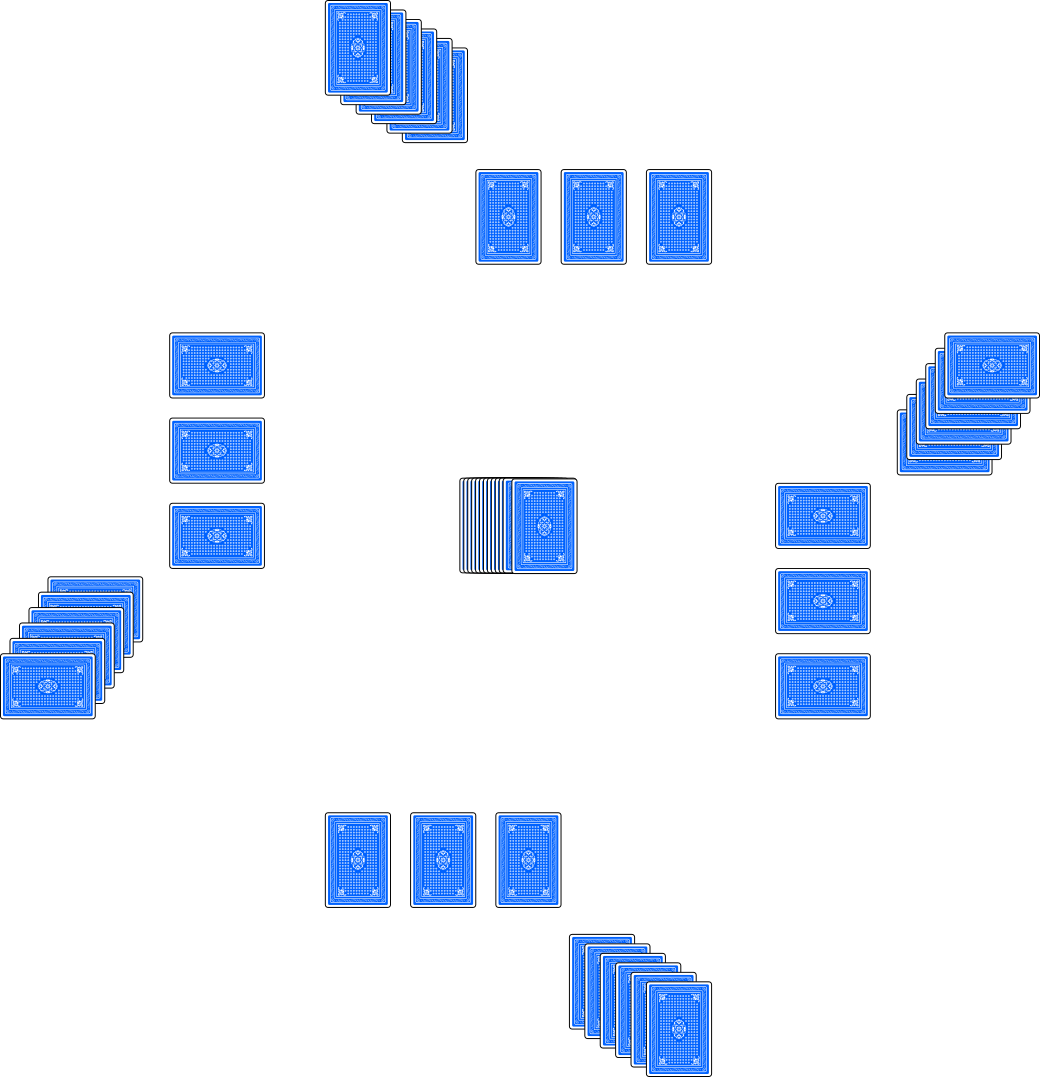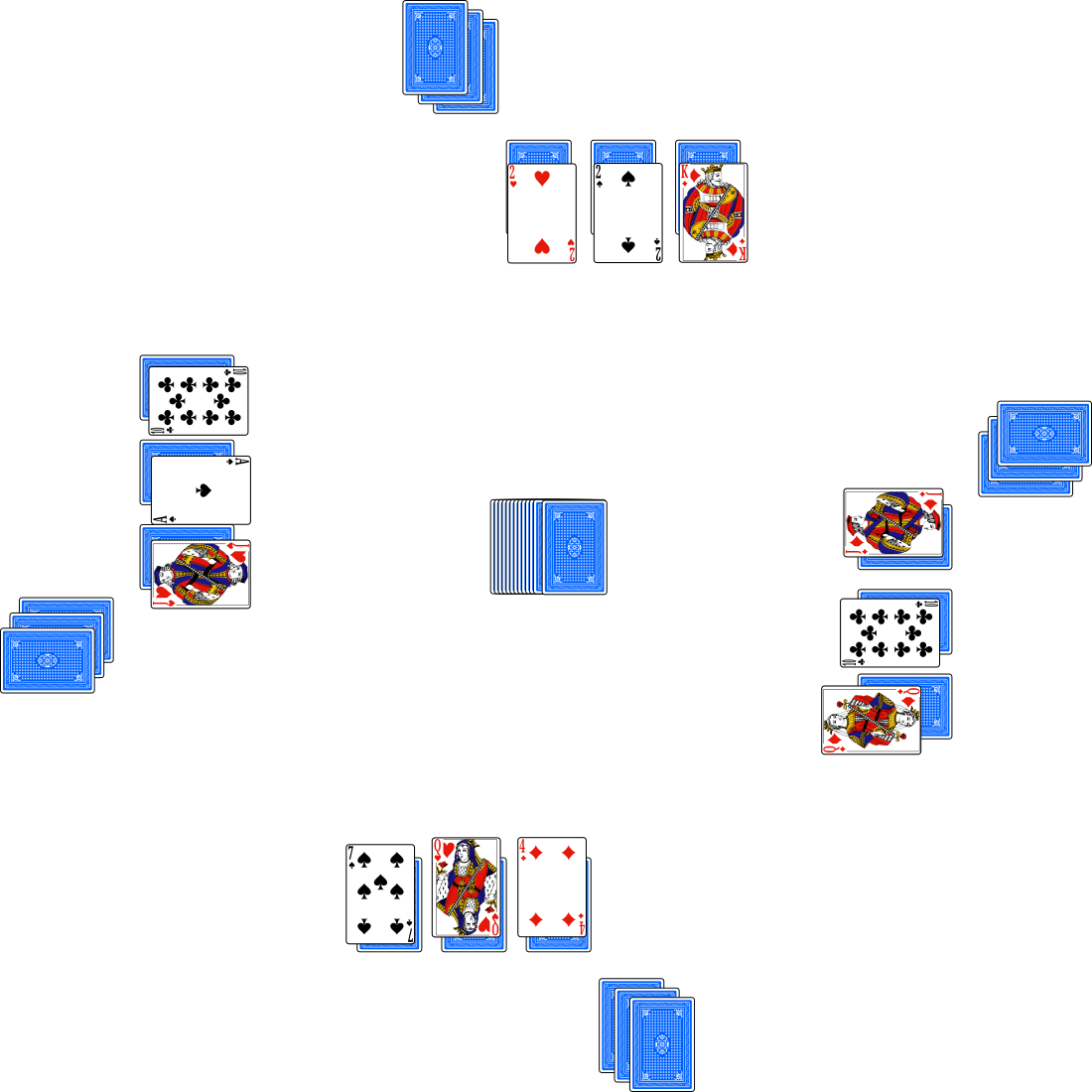I learned this game working at a restaurant. I later ran into least two other variations of it, both with different names and slightly different rules. The game is easy to learn but it looks complicated if you’re trying to learn the rules just by watching people play.
I like it because of the fast pace, easy set up, and balanced skill to luck ratio. Each game takes less than 5 minutes so the best way to do it is to keep a running tally with a group of friends. Then you can pick it back up any time. Alternatively you can play for the most wins out of a set number of games.
OG is balanced out so that even if you don’t know the strategy, you’re statistically likely to sometimes win. Skill bumps up your chance of winning in each game but it doesn’t allow you to consistently crush other players. This gives it a lighthearted feeling that pairs well with the fast pace.
OG Rules
Requirements: 3-5 Players; 3-5 minutes; 1 standard deck of cards (remove jokers)
Alternative requirements for 5-8 players: use 2 standard card decks mixed together. All rules are the same, except a “full set” requires 5 cards of the same rank instead of 4.
Optional: paper and writing utensil or counters of your choice like poker chips for keeping a tally of how many wins each person has
Dealing
Shuffle cards and deal each player three cards face down. These are their “blinds”. Deal each player 6 cards face down in a separate pile.
Place the remaining cards face down in the middle of the table as a draw pile.

dealing to four players
Players can now look at their pile of 6 cards. Each player must choose three “covers” - cards that go face up on top of their blinds. The covers should be the best three cards in your hand. Good cards are higher ranks or special cards (2, 3, 7, or 10). Aces are high.

selecting covers
The other three cards go in your hand.
Playing
If any player has a 4, they may immediately play it next to the draw pile to start the game. Whoever plays it first officially starts the round, but it should be noted that if other players have 4s, they may “sneak” them in regardless of the turn order. If nobody has a 4, someone may play a 5, and if nobody has a 5, someone may play a 6, and so on until the round starts.
Turns proceed clockwise. Each player must play a card that is equal to or higher than the card on the top of the pile. You can play multiple cards of the same rank. Any time you have less than three cards in your hand, you must immediately draw from the draw pile to replenish your hand, until the draw pile is empty. Players must draw from the draw pile in the order that they emptied their hands.
If you can’t beat the card on the pile, you must pick up the whole pile and play a new card from your hand to start the pile.
When the draw pile is empty, the objective is to get rid of all cards in your hand and all cards on the table (your covers and blinds). You cannot use your covers until your hand is empty, and if you use a cover, and then later have to pick up the pile, you must empty your hand again before using your covers.
Similarly, you can’t use your blinds until your covers are gone and your hand is empty. The player to empty their blinds first wins the game.
You must play your blind face up so the whole table can see it, even if it does not beat the pile.
Special cards
2,3,7, and 10 are all special cards.
2 can be played on any card, and it resets the pile, so the next player can play any card on the 2. It is a double-edged sword, because it saves you from picking up the pile, but it also guarantees that the next player can beat your card.
3 can be played on any card, and it forces the next player to pick up the pile and start it fresh with a card from their hand. The 3 is discarded immediately after being used.
A 7 can only be played on a card that it beats (2-7), but the next player must play a 7 or lower (or a 10).
10 is the best special card. It clears the whole pile, moving all cards to the discard pile, and allows you to start the pile fresh with another card from your hand. Before you start the new pile, you can and should draw from the draw pile if possible.
There is one other special card, a “full set”. If a player plays the final card that completes a set of 4 cards of the same rank (special or not), that card behaves exactly like a 10. It doesn’t matter who played the previous cards, only the player who plays the final cards gets to clear the pile and restart it.
Sneaking
Any time a card is played, if you have the same card in your hand, you may “sneak” it on top of the pile if it is not your turn. You then draw from the draw pile and the game continues as usual with the player who would have gone next before you snuck. You may sneak special cards (2,3,7, and 10), but they do not have any additional effects. If you sneak the fourth and final card of a full set, however, you do get to clear and restart the pile. Sneaking never changes the order of turns, and does not count as a turn. You cannot sneak while it is your turn.
Strategy
There’s not much strategy to the early game - just learn to sneak your low-ranking cards and get rid of your lowest card whenever possible. Save the highest cards and special cards (other than 7) and use them to save yourself from picking up the pile.
In the late game, things can get hairy. Try to remember cards in other players’ hands. The late game is a mix of sabotage and survival. Sometimes late game strategy is the exact opposite of early game strategy - for instance, you might sneak a 2 to prevent yourself from playing it and giving the next player a free play (normally you would save a 2). Sometimes you should play a high card to force the next player to pick up the pile, and sometimes you should save it because you know you’ll need it next time around. If you have a 10 in your covers, save it for last because then you get to play one of your blinds even if it turns out to be a low card.
That’s about it. Enjoy!
Thanks to David Bellot for the playing card graphics in the diagrams.